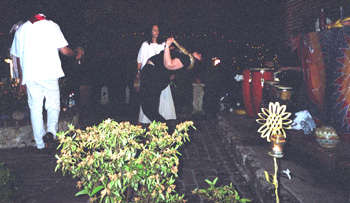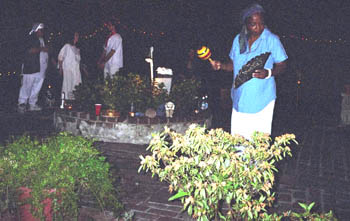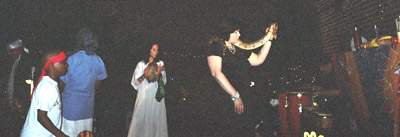
Dancing days are here again: A séance
Editor’s note: The following article was written as an honest and accurate account of experiences and observations taken from a Voodoo séance in the French Quarter of New Orleans. The writer had little prior knowledge of the Voodoo religion. The writer later contacted the overseer of the séance for a second explanation, based in part on concerns he had from being videotaped at said event. The explanation follows the article.
NEW ORLEANS — After two days spent wandering in and out of voodoo shops you begin to feel in need of a mental shower. Part of the taint arrives from too much touristy indulgence, like sampling every fast food joint back home in a mere couple of hours.
Forever steeped in a thicket of ambiguity and skepticism, Voodoo or Vodou has long been embedded in Creole culture, arriving by way of the region’s African slaves during the 18th century (and later by Haitian immigrants).
 |
| A man bends backward with a snake around him during the seance (Photos by Hunter Stephenson). |
A general amicability between local slaves and their masters allowed the religion to thrive outside of quiet private practice and enter the realm of public expression.
Today this phenomenon encompasses a zany cottage industry — even an AFL football team, the New Orleans Voodoo, manufactured on top of a provincial lifestyle that broils beneath with an ethereal authenticity, not unlike a Catholic gift shop.
But the dark history behind Voodoo lingers, so that the naïve visitor can stumble on more than an Orlando-spin: behind the American dollar are an astounding number of local adults satiating a very real desire for the occult. And for the most part these residents are not as easy to dismiss as the balding metal fan — their normality in dress and behavior stirs interest. One wishes to follow them unnoticed past midnight like an older sister in heat.
“Excuse me sir, I was wondering if there are any séances in the area this evening,” I ask, for some reason with the peculiarity of a British prep, to three separate voodoo shop employees. “Not tonight,” next up, “No and it’s private, but Esoterica has one tonight. They are up the street two blocks.”
“No, but there is one tomorrow night, behind Starling on 1022 Royal,” says the Judas Priest front man impersonator, er, employee (go figure) at Esoterica, a shop located on 541 Rue Dumaine.
“Sure, it starts at nine right behind the shop. And, yes, a priest will be there,” said a bespectacled, post-gradish man, his reply friendly yet purposely reserved. An aloof glance around Starling Magickal Books & Crafts finds nothing threatening in the afternoon, very purple- hats- and- stars- esque, and I leave before leaving an impression. But the store’s conservative traditionalism carries far more promise that I will leave on Monday with a satisfying clue about “real” Voodoo or Vodou; and not a flamboyant skeleton-man recollection of it.
The candidness of these employees is as off-putting as it is skeptical and a séance seems to require less effort to find than a proper weekend keggar in Miami. Perhaps it should all be chalked off to ignorance one way or the other. On Sunday, the group’s last night in New Orleans, I was going to attend.
Tipping a Hispanic version of the cabdriver from Scrooged, my associate Omar Sommereyns and I casually zoom in on a moderately attractive female, 20-ish, in jeans and flowing top as she exits a cab and walks through the narrow side gate entrance of Starling. At least we’ll have this outsider’s company, maybe more.
A streetlight is present, or maybe the moon, but the entrance is washed in medium blackness and a tall man, Grim Reaper-robed out, lets us in. Farther back, a man is hollering incomprehensibly — if he’s not trashed, he’s pissed — or a Southern evangelist. Hmmm, this might be good. But then the voice sweeps over a brick wall and onto the balcony of an old two-story house next door. Our side is regretfully quiet.
 |
| A woman dances to music during the seance. |
The makeshift path is straight-ahead, past a similar two-story house behind the shop, and opens into a courtyard lit by Christmas lights. Clock ticks 9:15 p.m., the scene looks delayed if not dead, and a bull skull hangs over a brick altar lined with candles.
In the center of the yard is a brick circle, across sits the outside girl and a chubby Haitian in a Tweetie-yellow wrap dress. Three ascending brick balls encapsulate the surroundings, and only if the pleasant lighting ceased, would one might say “trap.”
Various black-clad guests lounge in plastic chairs on a porch connected to the open-door house and Omar and I sit to the right of them in the corner underneath a stairwell. Conversation is light, awaiting the event, and an unidentified reporter is interviewing a heavyset lady with dyed black hair as a cameraman films her — great. The only objects predicting blood-drinking and an encounter with Satan (fingers crossed) are a disoriented Haitian boy whose age, just around six, says “corruption” as he pings a triangle and the sheathed machete laying by his tiny bare feet, which says “holy shit, maybe.”
Ten minutes later, restlessness sets in. Two men keep an apt beat on drums in between several lapses and the lack of focus mirrors a drum circle of ambiguously uninteresting burnouts. Suddenly a portly man of mixed complexion in a baggy outfit and a satin doo-rag laughably — somehow resembling a pope, a chef, and an overly-comfy suburbanite who dozed off watching the boob tube in ridiculous pajamas — begins a prayer, eyes tightly shut but active, four feet away from us. He announces that his name is Steven Denney in a relaxed dribble of tone. Here we go.
“We are here tonight to call the spirit of Mary Ellen Pleasant, a free woman of color who came to New Orleans in 1849 to initiate in Voodoo with Marie Laveau.” [Editor’s note: For information about Marie Laveau, see The Spellbinding Voodoo Business of New Orleans.]
The drummers are nearly in sync and seem to know that it is time for business. Denney begins squirting a thick, chalky powder on the ground from a nearby condiment container in the design that grows in elaboration from a cross to a swastika to that of a Native American dream catcher.
Called a “vever,” such a design informs that a Loa is being channeled and is the focal point of a séance. Meanwhile, a tired woman in a white gown begins to walk around the inner-circle barefoot, her eyes wide-open between brief pauses of shuteye. A black woman in sober condition wearing a blue headdress gently shakes a maraca of African colors as the young boy, presumably her son, hits the triangle with detached force between stamping in a small radius and mildly shaking.
Denney joins the robed woman beside the vever, brings her close and talks to her privately with his eyes shut, a consistent characteristic throughout the night. Placing his hand on the top of her head in a rotating motion she follows accordingly. This is no different from the actions of a heated televangelist, but the crowd (which reached a maximum of 14 people) are seemingly all local and, moreover, of a loosely binding acquaintance.
And Denney, who goes on to repeat this hand-on-head motion with a fascinating Oddville of characters: “the outsider girl,” a tall, handsome, and incredibly dazed gentleman who could pass for a French model, the lady in a white robe, a heavily made-up girl with a “Face Painter” sign on her back, the Tweetie-dress Haitian, among others, differs from such dramatic preachers because, well, actually he’s pretty similar, but the intention does not seem to be greed.
Bursts of laughter might burp through the surface at any minute, but Omar and I aren’t catching eye at the right moments, even though our attentions and thoughts are reveling equally in the absurdity. When the vever is lit on fire, humor is lost. One by one these people are put under the spell of the Loa by Denney, until the entire cast is stumbling around the circle in disjointed dance for the audience of less than six to watch — blankly. Is this the Electric Kool-Aid Acid Test? Could it have been this embarrassingly sad and trivial?
The woman being filmed earlier struts into the circle, thrusting about her neck is a yellow and green rope of muscle – a boa constrictor. She brings the serpent to the altar carefully and it extends, writhing over the surface as the Haitian dancer and white robed woman stand near like muses.
Desiring a different angle to snap photos with a cheap disposable, I leave my seat and walk left and stand in a corner behind the seated black-clad attendees. The back of a man’s t-shirt reads, “Devil’s Union Local 666.”
Lining up a shot, a bright light seems to illuminate only me, killing any photo-op. A cameraman is crouched on the stairwell above Omar, and seems to be directly focused on me. Overcome with a sense of recreationally surreal fear, this time I catch Omar’s eye and he nods in understanding.
The séance ends minutes later. People group and scatter as I back my bag and prepare to interview the Haitian Voodoo priest Steven Denney. Conveniently nigh, I attempt to introduce myself as a panicky man interrupts. He would like to know what type of rum the gods prefer. He might be mad, but Denney offers an immediate solution that calms the man and he leaves.
Like a patient elder, Denney agrees to do the interview and grabs a plastic chair. During the questioning his eyes remain shut. Roughly seven minutes in length, the taped interview is filled with an esoteric vernacular of impossibly named Voodoo gods, talk of mermaids, black and white Voodoo, the power of serpents and a peaceful digression on the loss of soul in the modern world. Admitting that spirits have been conjured tonight in this, the first ritual for Mary Pleasant (the last is on Halloween), Denney says that he experienced a strong time-gap at various periods, and emits a soft chuckle.
 |
| A man handles a snake during the seance. |
“This service is specifically designed for non-initiates, for people who, you know, everybody has spirits that come around them, family spirits; but this is a place for people to come and experience a safe environment the presence of the spirits of Voodoo,” said Steven Denney, a local resident and frequent visitor of Haiti, who says he’s been practicing Haitian Voodoo for 12 years.
“When you say ‘safe environment’ what does that…” I started to ask.
“In that there are initiates here who will make sure [everything is okay], but it’s not like we are doing a full on service, calling a lot of Loas, or spirits of Voodoo and a lot is happening all at once, says Denney. “We kind of keep it slow paced and really careful with everyone to make sure no one falls or [Writer’s note: word could not be transcribed from interview tape.], stuff like that.”
Denney grows slightly frustrated at my novice grasp of the topics of which he speaks and politely recommends various sources about town before walking away. Certain that other interviews would prove just as perplexing, Omar and I leave for the street and are directed from the premises by the lady with the snake. Eyes are on us and we do not leave donations on the altar.
Back on the street, there is not much to say in the first minutes and we need a drink. Bits of “I don’t know, man”-type phrases are thrown out like starter bait. Yes, this was a horribly kooky incident that we just witnessed, but neither of us is as blatantly critical as usual. A lot to chew on for the remainder of the evening — the séance was memorable — forever altering our perception of the French Quarter in a delightful riddle between reality and fluctuating doses of romanticism like a desk toy from Spencer’s Gifts.
Strolling back to the house with various members of the group, warmed by Guinness and a legal Absinthe beverage, the introspection has been allowed to continue without guilt into dawn. Nightmares are being stirred. However you spin the topic, the occult in New Orleans is alive and un-well. And the taint from such light dabbling is apparent weeks later.
The following is a reply from the Rev. Claudia Williams, owner of Starling, to a personal inquiry requesting further explanation about the event received via e-mail not long after the seance:
Dear Hunter:
I am the lady who held the boa at the ritual the other night. I am Rev. Claudia Williams, Vodou Priestess and High Priestess of the Temple of the Altar-Native Star here in New Orleans. I am also owner of Starling along with my husband, Jan Spacek.
The event was videoed and I was interviewed for an HDTV Cable show on New Orleans Vodou. They wanted to talk to me because of my standing in the Vodou community and the public rituals we do.
The house behind Starling is my husband and my home— we oversee it. We also have people work as security, quietly, during public rituals. I hope they did their jobs well and were not intrusive. I thought I got to tell everybody that if they fell on “our” property we could not be responsible. I didn’t do my usual long speech because the ritual was already underway when a few last people arrived and all those who arrived on time were regulars and know this house and the rules quite well.
On any given Sunday night, either I or Bon Houngan Wedo — Steven Denney lead the ritual. He is a member of The Roots Without End Society in Jacmel, Haiti. He and I work together sometimes or some Sundays I dance with my snakes and he leads the ritual or I lead the ritual and he drums. The Roots Without End Society and The Temple of the Altar-Native Star are not connected, but we have a very positive working relationship and he is always welcome to practice in our space. I work with Orisha Vodou and he works strickly with Haitian Vodou. The ritual you saw was a Haitain Vodou ritual. My work is with the Haitian Loa (Gods) as well as mostly the Orisha (Aftican Gods of another group of Vodou sects.) The serpent is ALWAYS sacred for various reasons and whenever possible you will see at least one in a Vodou ritual of any sort.
We announced that there was a time for questions after the ritual, did you not hear us?
Starling is an all around occult shop, we are not strictly suppliers to Vodou practitioners. We deal with supplies for High, Ceremonial, Egyptian Magick, Satanism of all kind, my husband and I are members of the O.T.O. so we deal with many aspects of Crowley study. We have clients who are Wiccan, Buddhist, Santerian / Vodoun, Native American practice— everything you might be able to think of.
You did not attend a “drum circle.” That implies either a non-specific music event or a Native American oriented ritual.
If I can assist you further, let me know.
Rev. Claudia Williams, STARLING
HPS, Temple of the Altar-Native Star, New Orleans

Comments are Closed